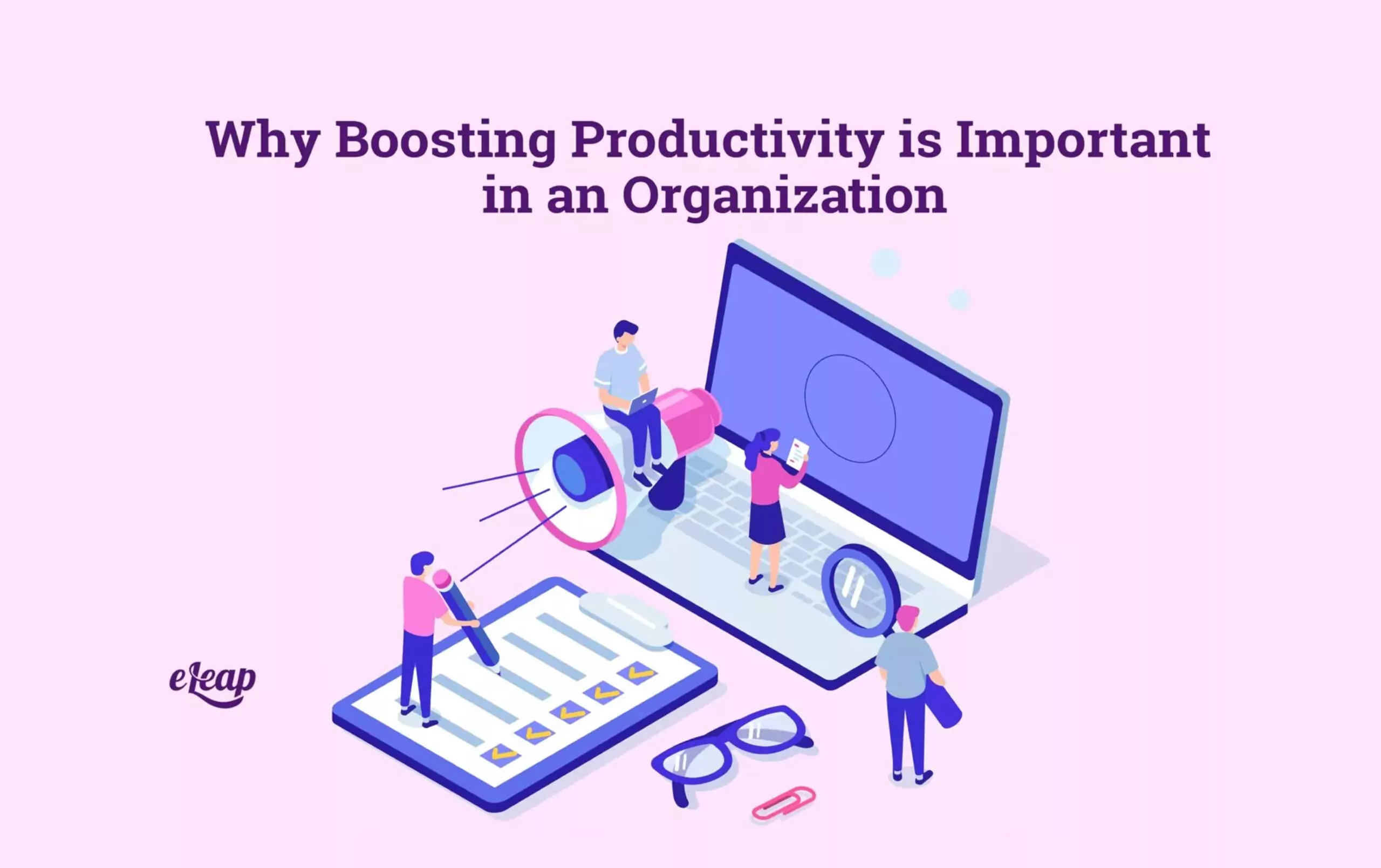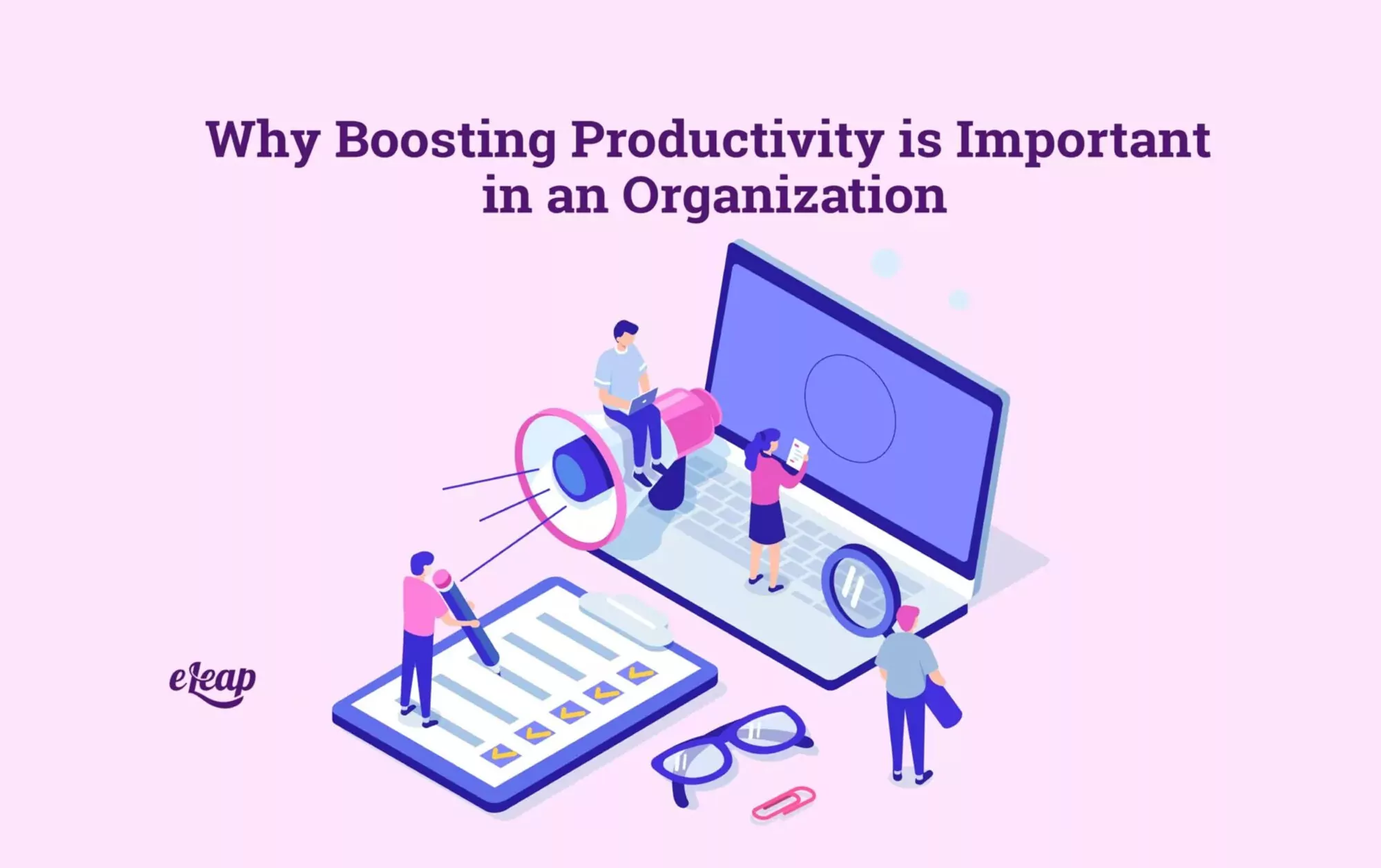Why Boosting Productivity is Important in an Organization

An organization’s success hinges on what its employees can produce, so boosting productivity in your workplace is crucial. By researching the best strategies to facilitate productivity, you can make a big difference in your team’s output.
Each individual employee will have inherent, natural levels of productivity. Although some employees may be naturally more productive than others, every employee can benefit from learning how to change habits that inhibit their productivity.
Hacks for Boosting Productivity at Work
Since our level of productivity is a mental game, it can feel hard to control or change. However, the opposite is true.
In the long run, the key to boosting productivity is changing habits. There are hacks and systems one can use to slowly change unproductive habits.
Though these systems work, they will take effort to implement. Habits are hard to break, even when we know they are negative ones.
Plus, productivity has an emotional component to it. If an employee struggles with productivity, a manager must ask themselves if it’s a matter of an underlying lack of motivation. An employee who feels unmotivated at work will have a hard time creating more productive habits, even with the tools to do so.
That’s why these hacks alone are not enough. To be successful in boosting productivity, these systems must be implemented alongside other efforts, such as changing one’s environment and addressing any underlying motivation issues.
For everyone, the effectiveness of certain productivity hacks will vary. One employee may find one hack to be life-changing, while another finds the same to be ineffective. People will likely need to try several systems before finding the combination that works for them.
With that said, below, you’ll find some common productivity hacks and systems which can improve employees’ day-to-day output and performance.

The Getting Things Done Method (AKA the GTD Method)
As promised, this productivity hack will help you get more things done. Developed by organizational consultant David Allen, this productivity system was popularized when David wrote a book about its benefits.
Essentially, the GTD method focuses on better time management and organization. The principles of the GTD method are simple:
- First, write everything down that needs to be done for the period. This could be for the day, week, or quarter – whichever way makes sense for your role.
- Next, break them down into actionable steps. If “write the Q2 financial report” is on the list of what needs to get done, break it down further. In this instance, you would write small milestones that need to happen to get there, such as “outline contents of Q2 financial report” or “set up a meeting time with collaborators on Q2 financial report”.
- Then, take all the actionable steps and group them into similar task types. For example, tasks that can be completed individually may go in one bucket, while tasks that require collaborators are in another.
- Finally, look at the list of tasks and schedule blocks of time to do them. This helps people stay on track by giving them a clear outline of when they should work on certain items, leading to better time management.
This method works for several reasons. For one, it takes the intimidation out of a to-do list by breaking down large projects into small, manageable steps.
Another reason the GTD method is successful is it encourages employees to regiment their time more efficiently, leading to less time wasted. The GTD method is used by many and is praised for its simplicity and effectiveness.
The Pomodoro Technique
Sadly, this productivity hack does not have anything to do with delicious pasta sauce. Luckily, this hack does provide a useful tool for employees to increase their productivity.
This technique is named for the tomato-shaped timer the creator, Francesco Cirillo, originally used to time his own tasks. The Pomodoro Technique is effective with people who have trouble getting started on tasks or need to focus on a task for short sprints.
The steps to the Pomodoro Technique are quite simple:
- Choose a task to attack and set a 25-minute timer.
- For the duration of that time, only work on the task at hand.
- When the timer is up, you have earned a five-minute break.
- Then, reset the timer for another 25 minutes. You can continue the same task or start a new one.
- After 4 “Pomodoro” periods, equaling one hour, a 30-minute break is earned.
This method is effective for several reasons. Research says that breaks are good for productivity, but not enough people take them. The Pomodoro Technique uses breaks as a reward for productivity. Rewards have been shown to boost motivation and productivity.
By using breaks as a reward, this technique kills two birds with one stone. It ensures the person is getting needed breaks, but also that they work for those breaks. This provides a greater sense of motivation.
Effective To-Do List Techniques
To-do lists are one of the oldest forms of productivity hack we still use today. Some people may find to-do lists overwhelming. If someone feels this way, they probably are not optimizing their to-do list.
It’s true that a long list of unfinished items lying on a page in front of someone can intimidate them. By being more intentional with to-do lists and optimizing them for productivity, they can be used with great success.
To write more effective to-do lists, follow these tips:
- Group similar tasks together. This can remind you how the tasks are related or in what order tasks must be done, helping to prioritize items.
- Break large tasks into smaller steps. Large tasks should be broken apart and have separate, mini to-do lists created for them. The mini-to-do list should itemize all actionable steps that need to be taken to achieve the goal.
- Group by timing. On your to-do list, items that need to be done at a set time (such as a meeting, presentation, etc.) should be separated from tasks that can be done anytime. This helps work around nonnegotiable commitments and makes time management easier.
When it comes to the effectiveness of to-do lists, consistency is key. If someone isn’t frequently updating their to-do list, they won’t find much use for it. To-do lists are easy to understand, simple to implement, and a great tool anyone can use.
Bullet Journals
Bullet journaling has become a popular organizational technique in recent history. This system, devised by a designer named Ryder Carroll, uses a single journal to track several ongoing responsibilities and tasks in one’s life.
The beauty of bullet journals is that they encourage the person using them to set up color codes for certain tasks. Information should be written in short bullet points (pointing to its name) and typically marked with specific colors and symbols to relate it back to a category.
Bullet journaling is great for those who are creative. Creatives may often find organizational techniques boring or mundane. Bullet journaling encourages people to add their own flare and create unique symbols for certain tasks.
This can motivate a creative mind to engage with organizational techniques, even if they normally have no interest.
Work in 90-Minute Intervals
One study found that elite performers, from musicians to athletes, do their best work in 90-minute intervals. The study found that going beyond a 90-minute interval could cause the quality of work to drop off.
This same study also found 4.5 hours of work per day is the optimal amount for most elite performers. The 90-minute interval technique, like the Pomodoro Technique, stresses the importance of uninterrupted work blocks and dedicated break time.
Is it Okay to be Unproductive?
Productivity is a focus in people’s careers, and they may start to feel guilty if their productivity declines. The truth is that productivity will naturally ebb and flow. Our emotions and personal lives make a big impact on our ability to be productive.
If you’re feeling chronically unmotivated, it may be time for an intentional reset. A vacation might be in order. Even taking just a couple of vacation days with the sole focus of relaxing and recharging can help.
It’s okay to feel unproductive from time to time; in fact, it’s natural. If you’re feeling constantly unmotivated at work, it may be time to reassess your career aspirations. Talking about career paths with a manager may help.
Bottom Line
Boosting productivity at work takes effort, but the rewards are well worth it. When we’re more productive, we feel more optimistic about our roles and prouder about our accomplishments.
With so many great productivity hacks and systems to try, it’s worth a shot. Productivity is the key to a happy and successful career.